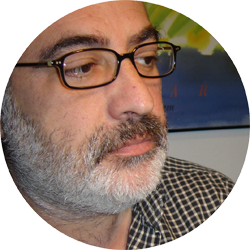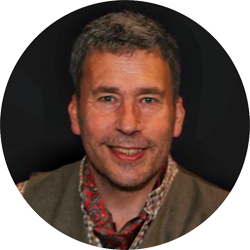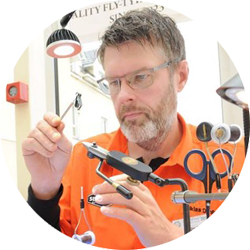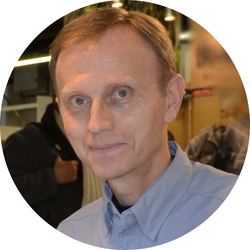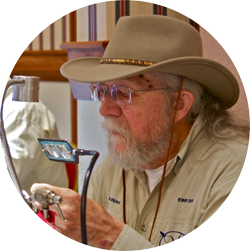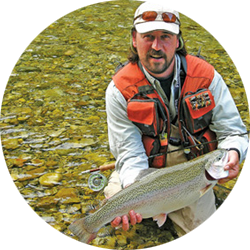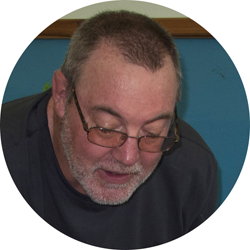
Hans van Klinken
Hans van Klinken retired from the army in April 2012. After a 35-year career, Hans left his position as Commander of the Royal Dutch Army Gunnery School. His retirement hours are consumed with fly fishing, fly tying, workshops, classes, lectures, writing, photography, and when he does find some spare time available, he continues his work as an outdoor journalist.
Hans was born in 1956 in Eindhoven in the Netherlands. As an inquisitive child, he began bait angling at the age of six in a nearby lowland brook called River Dommel. Then, the river was abundant with fish and was even known for a respectable population of brown trout too. Hans remembers his first experience with fly-fishing around the age of 15 while in Norway. He immediately fell in love with the unbridled beauty of the Northern Regions. He continued to regularly travel to Scandinavia to spend the summer holidays well into the late nineteen-nineties. Scandinavia offered a vast array of river systems and lakes that allowed Hans to hone his fly-fishing skills. His first venture into fly-tying occurred in 1976. Within three or four years he was creating his own designs. His preference for parachutes led him to develop several unusual patterns and tying techniques.
Hans admits that he was an absolute dry-fly purist until the early nineteen eighties. However, in 1984 he began to recognize the value of other types of flies such as, nymphs, streamers, and emergers. Unlike most noted European fly-fishers, Hans' first salmon and sea trout were being caught on dry flies.
Hans still ranks his greatest outdoor experience as one that occurred in 1975. On his last and longest student holiday, almost four months, he survived in the wilderness of Northern Lapland. He learned firsthand what it was like to survive in the forest and on the tundra. His mentor and teacher was an elderly Lap who mostly communicated with his hands and feet.
By the age 20 having possessed the desire and energy for travelling, Hans had seen and experienced large portions of the wilderness of northern Scandinavia. His travels included Germany, Denmark, Norway, Sweden, Russia and Finland. Here, his dry fly fishing landed him char, trout, grayling, pike, perch, whitefish, sea trout, arctic char, grilse and salmon. He fished places like Tjuonajokk, Alta and Tana rivers. He travelled to Spitsbergen (Svalbard), spent some time on the Lofoten and has visited Leningrad.
After nearly a decade (1971-1981) of exclusively fly-fishing in Scandinavia, Hans also began travelling to other European countries such as Ireland, England, Wales, Scotland, Belgium, Luxembourg, France, Austria and Switzerland.
When he related his success with his series of large dry-fly patterns and techniques, he was generally met with skepticism from the ‘experienced’ and noted fly fisherman. Maybe it was his youthful age of 20. Undaunted, Hans stayed on his chosen path and sought out those fisherman and friends with similar thoughts and ideas. His success with the large series of patterns he had developed in Scandinavia would prove to be enduring. In 1981 the army relocated them to the north of Germany. Now, living in even closer proximity to Scandinavia, more time on the water was possible for him. Fly-fishing became his lifelong obsession here. In 1982, for small groups of individuals who loved to fish in Scandinavia, Hans conducted his first private workshops in Bremen and Hamburg. His job in the army allowed for a good deal of ‘down time’ which in turn allowed him to visit and fish in Scandinavia waters between six and ten times a year. This was a perfect situation for building up a fly-fishing experience that would reach unprecedented dimensions.
In 1986 the Army took Hans back to Holland with a job that still permitted him to pursue his passion. He had little fly fishing experience in Holland and not many Dutch people knew much about him because he had spend so many years abroad. That began to change when he joined the general meeting of the Dutch Fly Fishing Association at a time when they were seeking new staff members. Hans joined as a member of the editorial staff of the Dutch Fly fishing magazine, and remained there for fifteen years. In addition, in 1986 he became the Dutch-area secretary of the Grayling Society in Holland. And he remains there today.
Hans also began to give more lectures, tying demonstrations and workshops. The year 1986 was a very memorable time in his fly-fishing career. He visited the US and was able to returned to England, Wales and Scotland again where his Klinkhåmer and Leadhead became proven successes. The Klinkhåmer Special's first real success occurred in the UK on the Welsh Dee where he fished with Ian Small. The stories of his unimaginable success on a beautiful stretch of the River Dee began to spread faster than a wildfire.
Hans is also well known for providing an excellent non-profit guiding service, mainly for worldwide friends in Scandinavia. Since 1996, he yearly travels to Canada where he spends his long summer holidays doing a lot of fly fishing and conducting fly-tying classes and workshops with kids and women. This allows him to test new patterns on Atlantic salmon, Pacific salmon, steelhead, different char species, shad, inconnu, whitefish, pike, grayling, trout, and small mouth bass. In his spare time he organizes some workshops and classes for fly-fishing novices and kids, up to seasoned veterans. He enjoys sharing his knowledge about fly-fishing and fly-tying, and is particularly skilled in the taking of Atlantic salmon and grayling on dry flies. Hans' most favourite patterns are parachutes, emergers, realistic nymphs and some large series of special Atlantic Salmon flies (dry, wet and nymphs). Since 1986, Hans has given several classes and workshops in the Netherlands, Wales, England, Belgium, Germany, Italy, Denmark, Norway, Sweden, Finland, Iceland, Canada, Asia and U.S.A.
From 2009-2012 Hans helped out the United Fly-Anglers Organization of Malaysia with some fly tying expertise and was deeply involved to realize the first International Fly Fishing Festival in Kuala Lumpur, one of the first fly-fishing and fly-tying events in this part of Asia.
He has written for many international and club magazines as well as contributing to several books by his friends, such as: Tying Flies with CDC by Leon Links, The World's Best Trout Flies by John Roberts, To Rise a trout by John Roberts, River trout flies by John Roberts, Fly Fishing for grayling by John Roberts, Trout on the nymph by John Roberts, Illustrated Dictionary of Trout flies by John Robers, Fly Tyers of the world volume 1 by Steve Thornton, Fly Tyers Masterclass by Oliver Edwards, The Complete Book of the Grayling by Ron Broughton, Fluer med historie by Mogesn Espersen, 60 fluer til regnbuer by Mogens Espersen, The Complete Book Of Fly Fishing by Malcolm Greenhalgh, Modern Atlantic Salmon Flies 1st and 2nd edition by Paul Marriner, 96 Sterke fluer some flyter by Pål Krogvold, Les plus belles mouches de peche by Nicolas Ragonneau, Fluebinderens bibel (Trout flies) by Barry Ord Clarke and many, many more. Today Hans write his own columns in magazines in US, Europe, Asia and Canada. He also works on several special fly-fishing projects.
Hans van Klinken's best-known patterns are the large L.T series, developed in Norway in the early eighties: All dry flies and these include the Klinkhåmer Special and ParaPoly Sedge. Also well-known are his Leadheaded grayling bugs, the Caseless Caddis series, the Remerger series, his Flymphs, the Baetis nymph and dun variation. In addition, the Once and Away series, the Ugly Bugs, his lake trout and inconnu streamers and the Culard series. Less well known are his personal productive series of salmon patterns, of which many are dries. Amazing are Hans' salmon nymphs and his unique and large Bondal series of wet salmon-flie.
Finally, Hans supports and sponsors wildlife and environmental projects close to his heart. He is noted for donating to charity all of his proceeds from auctions of his flies, and his appearance fees from "commercial" workshops and classes. Hans does all his workshops and classes for free, except once in a while he asks for some money for charity reasons or to pay his travel expenses now he is retired. Since 1986 Hans has returned thousands of dollars to different charitable projects and wildlife organizations.







